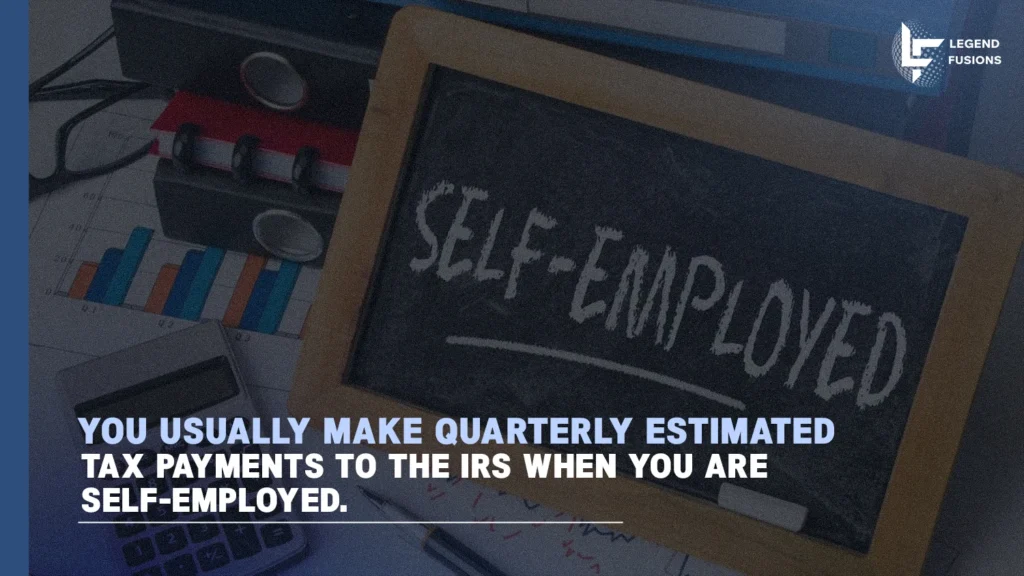Earning money on your own terms initially feels freeing, until you have to deal with taxes. Unlike employees who are subject to payroll taxes, you are responsible for your taxes when you are self-employed.
Many new freelancers, contractors, and small business owners often overlook this aspect, usually because simply thinking about it feels burdensome. It’s not when you have simple self employment tax instructions to refer to. Read our complete guide.
Contents
What Is Self Employment Tax?
Think of self-employment tax as the umbrella term for your Social Security and Medicare taxes. When you are an employee, your employer withholds a portion of your wages to cover these taxes, also called FICA (Federal Insurance Contributions Act) taxes. Your employer also contributes an equal amount.
However, as self-employed, you are considered both the employer and the employee. This means you are responsible for paying both the half of these taxes.
The purpose of these taxes is to fund Social Security benefits (retirement, disability, survivor benefits) and Medicare (healthcare for the elderly and disabled).

Who Pays Self Employment Tax
If you earn $400 or more in a tax year, even if it’s merely from a side hustle, you are generally considered self-employed and will need to pay self-employment tax.
The self-employed category is broad, usually including sole proprietors, individuals in a partnership, and independent contractors.
Self-Employment Tax vs Federal Tax
Let’s clarify a common misconception: self-employment tax does not automatically equate to federal income tax. Your self-employment income may also be subject to state income tax if the state where you live or are doing business imposes it. You usually have to pay for both.
You might be also interested in: Why Might Preparing Taxes Be Different for People Living in Different States?
What Are the Self-Employment Tax Rates?
The current self employment tax rate is 15.3% of your net earnings from self-employment. This 15.3% is broken down into two main parts:
- Social Security: 12.4%
- Medicare: 2.9%
Social Security Tax has a limit. The 12.4% tax portion above only applies up to a certain annual earnings limit (also known as the ‘wage base’). This limit changes each year. In 2025, the limit is $176,100. Over this amount, you stop paying the 12.4% self employment tax percentage.
The 2.9% Medicare portion, however, has no earnings limit; it applies to all your net earnings.
Additional Medicare Tax
If you are a higher-income earner, you will most likely be charged an Additional Medicare Tax of 0.9%. This applies to earned income (including net earnings from self-employment) above certain thresholds. In 2025, thresholds are at:
- $200,000 for single filers
- $250,000 for married filing jointly
- and $125,000 for married filing separately
This tax only applies to an individual; there is no employer equivalent.
Check out our guide to self employment tax brackets in 2025.
How to Calculate Your Net Earnings
Your net earnings are your gross income minus your allowable expenses. Here’s a simple way to calculate:
1. Start with Gross Earned Income
This is all the money you received from your self-employment activities. You might receive Form 1099-MISC or Form 1099-NEC from clients, but it is your responsibility to report all income, even if you do not receive these tax forms.
2. Subtract Allowable Expenses
This is where good bookkeeping truly pays off. The more legitimate business expenses you can deduct, the lower your net earnings will be, and consequently, the less self-employment tax you will owe. Common expenses include:
- Office supplies and software
- Advertising and marketing costs
- Professional fees (e.g., legal or accounting)
- Home office deductions (if you meet specific requirements)
- Business travel and meals (subject to specific rules)
- Depreciation on business assets (e.g., equipment, certain vehicles)
- Insurance premiums related to your business
- Web hosting and domain fees
3. Apply the 92.35% Rule
Here’s a key detail: The IRS only subjects 92.35% of your self-employment net earnings to self-employment tax. This accounts for the employer’s share of FICA taxes.
Example: If your gross earned income is $60,000 and your allowable expenses are $10,000, your net earnings would be $50,000. You would then multiply $50,000 by 92.35% (=$46,175) to find the amount subject to self-employment tax. Then, multiply this by 15.3% to get your actual self-employment tax.
Special Considerations
When Having Multiple Jobs
If you are both self-employed and employed, your employer’s Social Security and Medicare taxes contributions count towards your annual limits.
You will still calculate your self-employment tax on your net earnings from self-employment, but your overall Social Security tax might cap out if your combined earned income reaches the annual limit.
Foreign Earned Income Exclusion (Form 2555)
For self-employed US citizens or resident aliens living and working abroad (in a foreign country or commonwealth), the Foreign Earned Income Exclusion (FEIE) on Form 2555 allows you to exclude a certain amount of foreign earned income from US income tax. However, note that this excluded income is generally still subject to self-employment tax.
How to File Self-Employment Taxes
Your Form 1040 has several parts, all of which are integrated into your annual federal tax returns. Be sure to fill them in proper order:
1. Schedule C: Profit or Loss from Business (Sole Proprietorship)
Sole proprietors or independent contractors will generally use Schedule C first to report their income and expenses. This form is where you list all your gross receipts and deductible business expenses to arrive at your net earnings (or loss) from self-employment.
You will be using the net earnings figure from your Schedule C to calculate your self-employment tax (see next part).
2. Schedule SE: Self-Employment Tax
This serves as your calculator tax form. You take the net earnings amount from Schedule C (or from Form 1065, Schedule K-1 if you are a partner in a partnership), apply the 92.35% rule, then multiply by the 15.3% self employment tax rate.
Your Schedule SE will guide you through this calculation step-by-step. The resulting self-employment tax amount from Schedule SE is then transferred to your main Form 1040.
3. Form 1040: U.S. Individual Income Tax Return
Your total self employment tax Schedule SE calculation will be reported on your main Form 1040, then used to work out your adjusted gross income (AGI) and consequently, tax bill. You are allowed to deduct one-half of your total self-employment tax paid from your gross income. It is an above-the-line deduction, meaning you do not need to itemize to claim it.
Example: If your calculated self-employment tax is $7,000, you can deduct $3,500 from your gross income on your Form 1040.
How to Pay Your Taxes to the IRS
The US operates on a ‘pay-as-you-go’ tax system. If you expect to owe at least $1,000 in tax for the year (including self-employment tax and income tax), you are generally required to make quarterly estimated tax payments to the IRS:
- Q1 (Jan 1 to March 31): Due April 15
- Q2 (April 1 to May 31): Due June 15
- Q3 (June 1 to Aug 31): Due September 15
- Q4 (Sept 1 to Dec 31): Due January 15 of the next year
Not paying enough tax by these deadlines might lead to penalties.
Tip If You Are Also an Employee: If you also have a W2 job (as an employee), you can increase the withholding taxes from that job’s paycheck to cover your estimated self-employment tax liability. This might be simpler than making separate quarterly payments.
Relevant read: How to Fill Out W4, Employee’s Withholding Certificate

How to Lower Your Self-Employment Tax
Aside from your legitimate business expenses and eligible deductions (in Form 1040), here are some tax planning strategies that may help you lower your self-employment tax:
Review Your Bookkeeping System
You cannot claim deductions if you do not track your receipts, invoices, bank statements, and mileage logs. Be sure to implement a strong bookkeeping system from day one. This also helps you defend your claims in the event of audits.
Consider Your Business Structure
This is a specialist topic but worth touching on. Some self-employed individuals consider electing to be taxed as an S Corporation. With an S Corp, you pay yourself a ‘reasonable salary’ (subject to payroll taxes), and any remaining profits distributed to you are generally not subject to self-employment tax.
There are additional administrative costs and complexity, however, so be sure to consult a tax professional before making a decision.
Earned Income Credit
The earned income credit (EIC) does not directly reduce your self-employment tax, but if you qualify, this could reduce your overall tax bill or result in a refund. The EIC is a refundable tax credit for low to moderate-income working individuals and families, which you may usually qualify for if self-employment is your main source of income.
Seek Professional Tax Advice
Being self-employed offers incredible freedom and opportunity, but it also places the responsibility of tax compliance squarely on your shoulders. If you need personalized self employment tax instructions, Legend Fusions is here to offer you comprehensive advice. Talk to our tax advisor today!
Reviewed by:

Hira Asif
Hira Asif, Client Manager (US) at Legend Fusions, brings over 11 years of tax expertise, including 8 years with Ernst & Young. Her work focuses on tax advisory, compliance, and planning for individuals, partnerships, and private equity funds. With a deep knowledge of federal, state, and local tax regulations, Hira is skilled in identifying tax planning opportunities and reviewing corporate and partnership tax returns to optimize compliance and reduce exposures.

